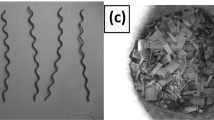Abstract
The objective of this investigation was to examine methods of testing round Steel Fibre Reinforced Concrete (SFRC) panels to obtain empirical estimates of post-crack load capacity under point loads. The performance of steel fibre reinforced concrete panels under point loads is of interest because such tests are commonly used to determine the suitability of a concrete mix for use in sprayed tunnel lining construction. This investigation has focussed on experimental obstacles to the reliable determination of post-crack load capacity.
To examine possible differences in behaviour between continuousin situ tunnel linings and specimen panels representing portions of a lining, four modes of edge support were used to restrain round specimens that varied in both thickness and diameter. Determinate and simple support conditions were examined as possible modes of panel support for routine laboratory testing. Fully clamped and quasi-continuous edge restrained panels were used as approximations of anin situ lining. Performance was measured in terms of peak load capacity and energy absorption.
Résumé
L’objectif de cette étude était d’obtenir des estimations sur la capacité d’un béton renforcé de fibres d’acier (steel fibre reinforced concrete, SFRC) à supporter une charge après fissuration. La résistance des panneaux de SFRC sous charge présente un interêt parce que ces essais sont souvent utilisés pour déterminer les propriétés d’un mélange de béton utilisé pour la construction des tunnels. L’object de cette recherche est d’étudier les problèmes pratiques et empiriques pour déterminer la capacité post-fissuration.
Pour examiner les différences entre les revêtements d’un tunnel continuin situ et les specimens qui les représentent dans ces épreuves, quatre formules de support ont ét’e utilisées pour retenir des éprouvettes circulaires variant en épaisseur et en diamètre. Les conditions de support determinantes et simples ont été examinées comme moyens de support des panneaux pour les essais en laboratoire. Des panneaux complètement maintenus et de façon quasicontinue ont été utilisés comme modèles approximates des revêtements continuin situ. Les résultats ont été mesurés en termes de capacité ultime sous charge et aussi par l’absorption d’énergie. L’étude a révélé que le mode de support déterminant présente certains avantages empiriques par rapport aux alternatives.
Similar content being viewed by others
References
Vandewalle, M. ‘Tunnelling the World’, 4th ed., (Bekaert, 1996).
Kaiser, P. K. and McCreath, D. R., ‘Rock Support in Mining and Underground Construction’, (A.A. Balkema, Rotterdam, 1992):
Roux, J., Cheminais, J., Rivallain, G. and Mourand, C., ‘Béton projeté par voie sèche avec incorporation de fibres’,Tunnels et Ouvrages Souterrains 92 (1989) 61–97.
European Specification for Sprayed Concrete, European Federation of National Associations of Specialist Contractors and Material Suppliers for the Construction Industry (EFNARC, 1996).
Meylbye, T. ‘Sprayed concrete for rock support’, (MBT International, 1994).
Bernard E. S. ‘The Behaviour of Round Steel Fibre Reinforced Concrete Panels under Point Loads’, Engineering Report CE8 (University of Western Sydney, Nepean, 1998).
American Society for Testing and Materials Standard C-1018 ‘Test Method for Obtaining Flexural Load vs. Deflection Behavior of Fiber-Reinforced Concrete’, (ASTM, Philadelphia, 1994).
Johansen, K. W. ‘Yield Line Theory’ (Cement and Concrete Association, U.K., 1972).
Bernard, E. S. ‘Flexural Behaviour in Square Steel Fibre Reinforced Concrete Slabs’, Proceedings of CONSEC’98 Conference, Tromsø, Norway, June 21–24 1998.
Falkner, H., Huang, Z. and Teutsch, M., ‘Comparative study of plain and steel fibre reinforced concrete ground slabs’,Concrete International 20(1) (1995) 45–51.
Author information
Authors and Affiliations
Rights and permissions
About this article
Cite this article
Bernard, E.S. Behaviour of round steel fibre reinforced concrete panels under point loads. Mat. Struct. 33, 181–188 (2000). https://doi.org/10.1007/BF02479412
Received:
Accepted:
Issue Date:
DOI: https://doi.org/10.1007/BF02479412



